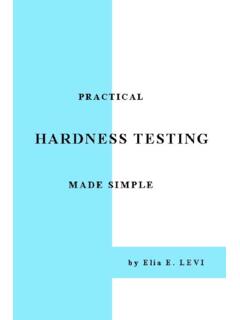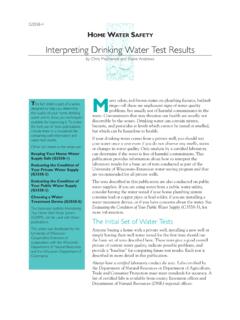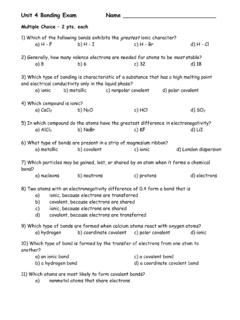Transcription of 1. ROCKWELL HARDNESS TEST II. APPARATUS: III. THEORY: a ...
1 AURORA S TECHNOLOGICAL AND RESEARCH INSTITUTE,UPPAL,HYD DEPARTMENT OF MECHANICAL ENGINEERING MECHANICS OF SOLIDS 1 1. ROCKWELL HARDNESS TEST 1. AIM: To determine the ROCKWELL HARDNESS of a given test specimen II. APPARATUS: ROCKWELL HARDNESS testing machine, Test specimen. III. THEORY: HARDNESS -It is defined as the resistance of a metal to plastic deformation against Indentation, scratching, abrasion of cutting. The HARDNESS of a material by this ROCKWELL HARDNESS test method is measured by the depth of Penetration of the indenter. The depth of Penetration is inversely proportional to the HARDNESS . Both ball or diamond cone types of indenters are used in this test.
2 There are three scales on the machine for taking HARDNESS readings. Scale A with load 60 kgf or N and diamond indenter is used for performing tests on thin steel and shallow case hardened steel. Scale B with load 100 kgf or N and mm dia ball indenter is used for performing tests on soft steel, malleable iron, copper and aluminum alloys. First minor load is applied to over come the film thickness on the metal surface. Minor load also eliminates errors in the depth of measurements due to spring of the machine frame or setting down of the specimen and table attachments. The ROCKWELL HARDNESS is derived from the measurement of the depth of the impression EP = Depth of penetration due to Minor load of N.
3 Ea = Increase in depth of penetration due to Major load. E = Permanent increase of depth of indentation under minor load at N even after removal of Major load. This method of test is suitable for finished or machined parts of simple shapes. AURORA S TECHNOLOGICAL AND RESEARCH INSTITUTE,UPPAL,HYD DEPARTMENT OF MECHANICAL ENGINEERING MECHANICS OF SOLIDS 2 IV. PROCEDURE: 1. Select the load by rotating the Knob and fix the suitable indenter. 2. Clean the test-piece and place n the special anvil or work table of the machine. 3. Turn the capstan wheel to elevate the test specimen into contact with the indenter point. 4. Further turn the wheel for three rotations forcing the test specimen against the indenter.
4 This will ensure that the Minor load of N has been applied 5. Set the pointer on the Scale dial at the appropriate position. 6. Push the lever to apply the Major load. A Dash Pot provided in the loading mechanism to ensure that the load is applied gradually. 7. As soon as the pointer comes to rest pull the handle in the reverse direction slowly. This releases the Major, but not Minor load. The pointer will now rotate in the reverse direction. 8. The ROCKWELL HARDNESS can be read off the scale dial, on the appropriate scale, after the pointer comes to rest. V. OBSERVATIONS: Material of test piece = Thickness of test piece = HARDNESS Scale used = Minor Load = Major Load = Test No.
5 1 2 3 4 Hard ness value AURORA S TECHNOLOGICAL AND RESEARCH INSTITUTE,UPPAL,HYD DEPARTMENT OF MECHANICAL ENGINEERING MECHANICS OF SOLIDS 3 VI. PRECAUTIONS: 1. For testing cylindrical test specimen, use V-type platform. 2. Calibrate the machine occasionally using standard test blocks. 3. For thin metal prices place another sufficiently thick metal piece between the test specimen and the platform to avoid any damage which may likely occur to the platform. 4. After applying Major load, wait for sometime to allow the needle to come to rest. The waiting time vary from 2 to 8 seconds. 5. The surface of the test piece should be smooth and even and free from oxide scale and foreign matter.
6 6. Test specimen should not be subjected to any heating or cold working. 7. The thickness of test piece or of the layer under test should be at least 8 times the permanent increase of depth of E . 8. The distance between the centers of two adjacent indentation should be at least 4 indentation to the edge of the test piece should be at least times the diameter of the indentation. VII. VIVA QUESTIONS: 1. Define HARDNESS . 2. Applications of ROCKWELL HARDNESS A Scale, B-Scale, C-Scale. 3. Type of Indentor used in the Three Different Scales of ROCKWELL HARDNESS Test. 4. Different Types of HARDNESS Testing Methods. 5. Size of the Ball to be used in Ball Indentor of ROCKWELL HARDNESS Test.
7 6. Diameters of the different Balls used in Brinell HARDNESS Test. 7. Selection of Load in Brinell HARDNESS Test. 8. Selection of Load in ROCKWELL HARDNESS Test. AURORA S TECHNOLOGICAL AND RESEARCH INSTITUTE,UPPAL,HYD DEPARTMENT OF MECHANICAL ENGINEERING MECHANICS OF SOLIDS 4 Figure: HARDNESS Testing Machine AURORA S TECHNOLOGICAL AND RESEARCH INSTITUTE,UPPAL,HYD DEPARTMENT OF MECHANICAL ENGINEERING MECHANICS OF SOLIDS 5 2. BRINELL HARDNESS TEST I. AIM: To determine the Brinell HARDNESS of the given test specimen. II. APPARATUS: Brinell HARDNESS machine, test specimen. Brinell Microscope III. THEORY: INDENTATION HARDNESS -A number related to the area or to the depth of the impression made by an indenter or fixed geometry under a known fixed load.
8 This method consists of indenting the surface of the metal by a hardened steel ball of specified diameter D mm under a given load F(kgf) and measuring the average diameter d mm of the impression with the help of Brinell microscope fitted with a scale. The Brinell HARDNESS HB is defined, as the quotient of the applied force F divided by the spherical area of the impression HB = Test load in kgf/surface area of indentation = 222)(2mmkgdDDDF IV. PROCEDURE: 1. Select the proper size of the ball and load to suit the material under test 2. Clean the test specimen to be free from any dirt and defects or blemishes. 3. Mount the test piece surface at right angles to the axis of the ball indenter plunger.
9 4. Turn the platform so that the bal is lifted up. 5. By shifting the lever apply the load and wait for some time. 6. Release the load by shifting the lever. 7. Take out the specimen and measure the diameter of indentation by means of the Brinell microscope. AURORA S TECHNOLOGICAL AND RESEARCH INSTITUTE,UPPAL,HYD DEPARTMENT OF MECHANICAL ENGINEERING MECHANICS OF SOLIDS 6 8. Repeat the experiment at other positions of the test piece. 9. Calculate the value of HB. V. OBSERVATIONS: Test Piece Material = Diameter of Ball D = Load selection F/D2 = Test Load F = Load application time = Least count of Brinell Microscope = HB = 222)(2mmkgdDDDF Impression Diameter F in kG T in sec D in mm HB Kg/mm2 d1 d2 221dd Average value of HB = VI.
10 PRECAUTIONS: 1. The surface of the test piece should be clean. 2. The testing machine should be protected throughout the test from shock or vibration. 3. The test should be carried out at room temperature. 4. The distance of the center of the indentation from the edge of the test piece should be at least times the diameter of the indentation and the distance between the center of two adjacent indentations should be at least 4 times the diameter of the indentation. AURORA S TECHNOLOGICAL AND RESEARCH INSTITUTE,UPPAL,HYD DEPARTMENT OF MECHANICAL ENGINEERING MECHANICS OF SOLIDS 7 5. The diameter of each indentation should be measured in two directions at right angles and the mean value of the two readings used for the purpose of determining the HARDNESS number.







